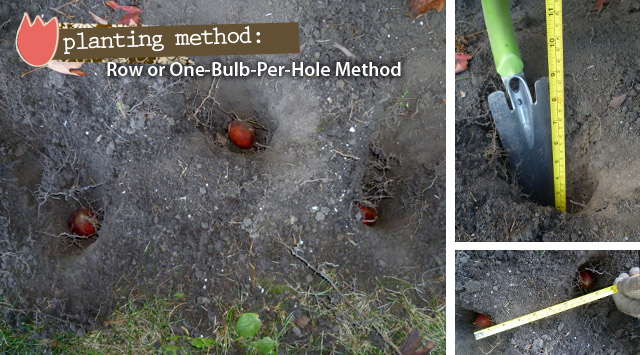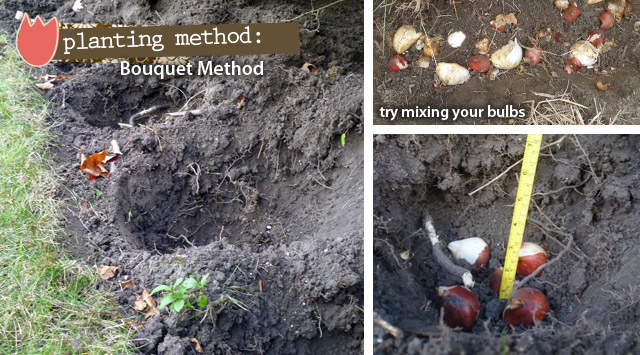 The weather here in the upper Midwest has been pretty perfect for being outside: warm sun, dry air, cool nights…more than a gardening girl like me could ever ask for! So over the past few days, I’ve stolen a few hours to myself to get outside and get my spring-blooming bulbs in the ground. After all, it just isn’t right that the house of the horticulturalist is absent of color in the spring.
The weather here in the upper Midwest has been pretty perfect for being outside: warm sun, dry air, cool nights…more than a gardening girl like me could ever ask for! So over the past few days, I’ve stolen a few hours to myself to get outside and get my spring-blooming bulbs in the ground. After all, it just isn’t right that the house of the horticulturalist is absent of color in the spring.
Therefore, I went about my task of adding over 300 bulbs of different varieties to our front landscape. Considering our house has a very traditional, colonial look, I wanted to stick with some very classic, bold colors. My selections included Red Apeldoorn Darwin Hybrid Tulips, Dutch Master Daffodils, Tete-a-Tete Miniature Daffodils (one of my fave flowers of ALL-TIME), and then a mixture of Grape Hyacinth Muscari and Scilla. While planting, I decided to demonstrate two methods of planting bulbs: the row or one-bulb-per-hole method and the bouquet method. Determining which one you’ll use when planting your bulbs really depends on the look you are going for. In this post, I’ll explain the differences in each method and how to go about achieving both.
Row or One-Bulb-Per-Hole Method
I think the implications of this method are pretty obviously simply by reading the name. This is the method which most gardeners use and think when planting bulbs. In this method, a single hole is simply dug for each bulb to be planted. This hole is dug to the appropriate depth for the variety of bulb (typically 2-3 times the height of the bulb) and not much wider than the bulb itself. The bulb is then placed in the bottom of the hole, pointed-side up if applicable, and then the hole filled with dirt. If planting in this method, it is somewhat more important to make use of a tape measure in determining where to dig the next hole. Obviously, these measurements don’t have to be exactly the same, but with a few inches is important to give you the uniform look you are going for. If planting multiple rows, staggering your planting (planting holes on a diagonal) will give a much fuller look and appear less like soldiers standing at attention.
This method is very good in applications where a “formal” look is desired. Since all of the bulbs will be evenly spaced, it can also be good in large areas where a massing or “sea of color” is desired. The drawbacks to this method is that precision of measurements is a tad more important and the planting itself takes more time and involves more labor.
Bouquet Method
Again, the name of this method gives away much of the idea behind it. In this method, instead of planting one bulb per hole, a larger hole is dug and an odd number of bulbs is placed in the bottom. This method achieves more of a natural-looking “bouquet” of blooms in the landscape rather than evenly spaced blooms. For instance, if planting a large number of tulip bulbs, a hole approximately 10-12″ across and 6-8″ deep would be dug. Five to seven tulip bulbs would then be placed, pointed-side up, in the bottom of the hole and the hole filled in. When placing the bulbs in the bottom of the hole, all rules of spacing go out the window. Personally, this is the method in which I typically plant and I always just make sure that the hole is dug large enough so that the bulbs are not touching. When digging these larger holes, it is important to create as flat of a bottom to the hole as possible (a shape resembling that of a soup can) so that all of the bulbs in the hole are planted at the same depth. This can be somewhat challenging to accomplish, especially when using a spaded shovel with a pointed end. You may find it helpful to use a pointed-spade shovel when digging the majority of the hole but then switching to a flat or straight shovel to level the bottom. One big advantage of planting in bouquets is that as long as you are working with bulbs of similar planting depth requirements (such as tulips and daffodils or grape hyacinth and scilla), you can feel free to mix them up within the same hole to achieve a longer bloom time and a bigger varieties of blooms in the same area without leaving space between them as you would in the row method.
This method works excellent in areas where a natural, more “free-form” look is desired. Planting in bouquets is also much more manageable when working around other existing plants, structures, or along a wooded edge. The drawbacks of this method include the requirement of larger tools (I personally would hate to dig holes this large with a simple hand trowel) and the necessity of a little larger space to create such a large hole. It also is a little bit more of an investment as it typically calls for a larger number of bulbs.
Hope all of that made sense. It’s kind of a difficult concept to explain and therefore, I’ve included lots of pictures to illustrate the two differing methods. I know one thing is for certain: I can hardly wait to enjoy the results of my labor next spring! Also, Holland Bulb Farms has developed a special collection of the bulbs I’ve used in my front yard this year so you can watch your bulbs grow along with mine! I obviously, highly recommend the color and flower combination.






